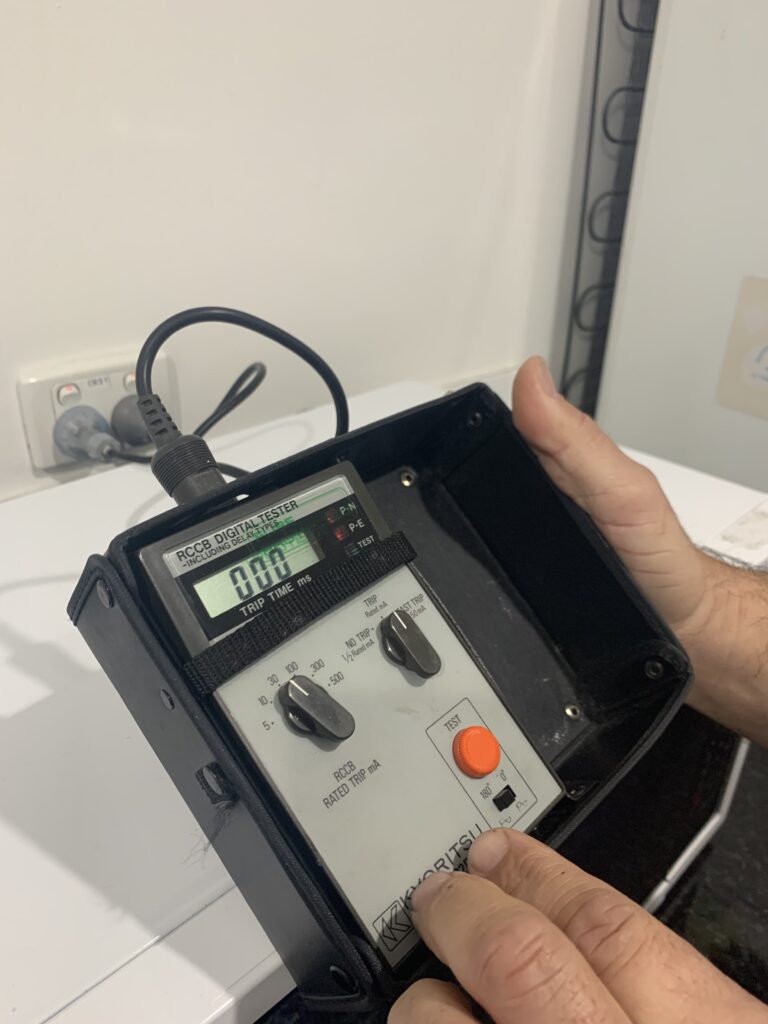
RCD testing is the process of safely “tripping” your RCD to ensure it will operate quickly should there be an electrical incident. This is also known as safety switch testing. Your RCD is designed to trip, or switch off all the power to that circuit. Australian and New Zealand standards detail the maximum “trip times” for various RCD’s and the competent technician testing your RCD will be able to determine whether your RCD is tripping quickly enough. The quicker a RCD trips, the smaller the electric shock sustained by an individual.
Push button testing of your RCD is also required under Australian Standards on a 6 monthly basis. This can be completed by the responsible staff member or by the technician you are engaging to complete electrical safety services.
What is an RCD?
An RCD is an acronym for Residual Current Device. They can sometimes be called ELCB’s (Earth Leakage Circuit Breakers) or Safety Switches.
An RCD monitors the flow of electricity through the circuit it is attached to. Should any abnormalities associated with the delivery of an electric shock or fatal electrocution be detected by the RCD, the unit will shut off the power to the circuit immediately to minimise injury.
An RCD is a life saving device, but it does not completely eliminate the risk of electric shock. It must be tested to ensure it is working within the safety standards.
Does our “Safety Switch” (RCD) need regular testing and tagging?
Yes. Your RCD needs to be tested and tagged in accordance with AS/NZS 3760:2022 to ensure that it will respond in a fault situation, and that it will also respond within the required time frame. Should it not trip in the required time, a fatal and extensive electric shock may be delivered.
Additionally, WHS Regulations state all businesses must have a RCD protecting all hostile circuits, and that the RCDs must be tested in accordance with AS/NZS 3760:2022.
ATS will inspect, test and tag your RCDs to ensure that they comply with the standard and safe lives in an emergency situation.
Why should I have an RCD/ELCB or Safety Switch in my workplace?
RCDs and ELCBs are commonly called Safety Switches. These devices can be fitted to your distribution board, or can be portable. They monitor the flow of electricity through your site, and should abnormalities associated with electric shock/electrocution be detected, the unit will shut off power immediately to minimise injury.
It is quite common for electrical circuits in commercial and industrial buildings to be unprotected by safety switches. Should a fault occur in an electrical appliance when it is connected to a socket outlet that is not protected by an RCD, serious or fatal electric shock could occur. If you do not have RCD protection in your workplace, ATS highly recommend you engage a licenced electrician to install RCDs across all circuits in your workplace.
Whilst mandatory to have RCDs installed on all hostile environment circuits, installing a RCD and ensuring all electrical appliances and RCDs are inspected, tested and tagged in accordance with AS/NZS 3760:2022 is the best method of ensuring electrical safety for your workplace.
How do I know if I have an RCD?
The only way to know this is to open your switchboard and check. It is perfectly safe to open the main door as you will not have to remove any guarding on your switchboard to locate your RCD.
If you are in any doubt, please contact ATS. Your local ATS technician will be able to quickly identify whether your workplace is protected by RCD.
WHS Regulations state RCDs must be installed on hostile environment circuits and for these RCDs to be inspected, tested and tagging in accordance with AS/NZS 3760:2022.
What is a Portable RCD?
Portable RCDs can look like large Powerboards, or can only have one power outlet. They do however have an internal RCD that will trip should any leakage from the circuit occur whilst in use.
Portable RCD units are recommended to be used when using any tool inside or outside. These devices are designed to trip in a maximum of 30 milliseconds and will most likely save you from electric shock.
Do my portable RCD’s need testing and tagging?
Yes. Your portable RCD needs to be tested to ensure that it will respond to a fault situation and that it will also respond within the required time frame. Should it not trip in the required time, a dangerous and extensive electric shock may be delivered.
ATS can test and tag your portable RCDs to ensure that they comply with AS/NZS 3760:2022.
We have a “Safety Switch” installed. Aren’t my staff protected against electric shock?
No, not entirely. A Safety Switch or Residual Current Device (RCD) only protects against electrical faults where electricity leaks from the circuit. Thats exactly what happens in the event of an electric shock.
In January 2012 it become mandatory for all hostile environment circuits in Australian workplaces be fitted with RCDs as these devices will reduce the severity of any electric shock and will most certainly save lives.